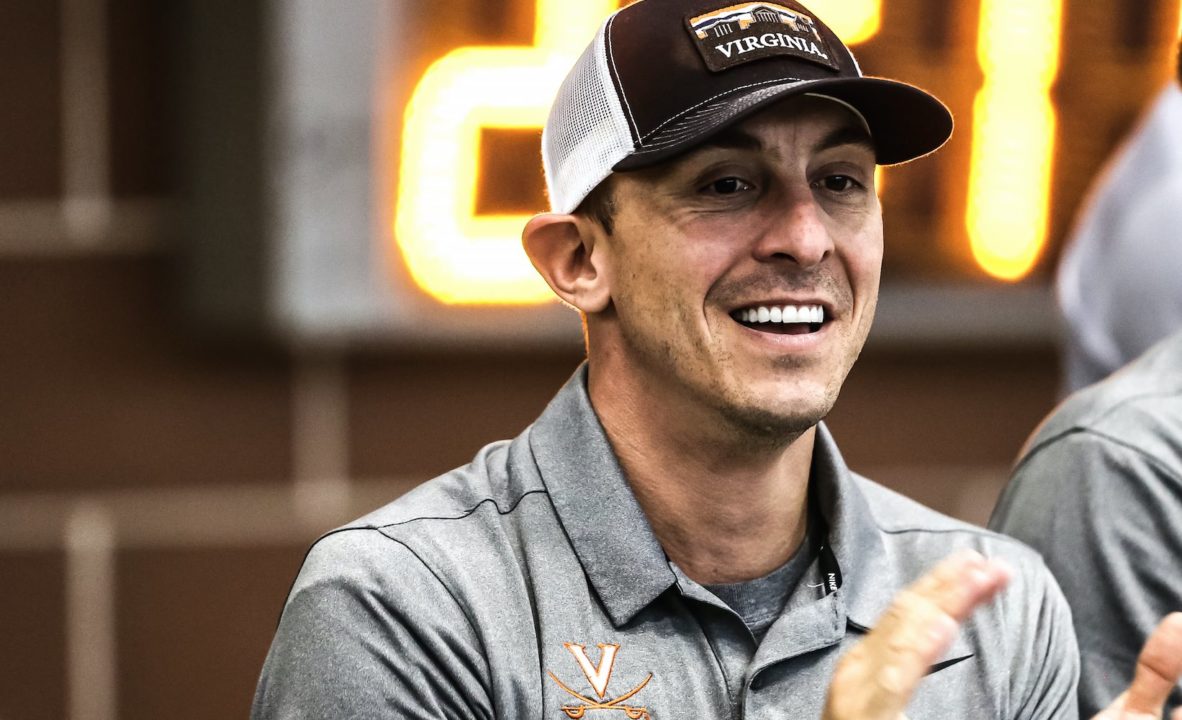Every now and then at SwimSwam, we’ll get a copy of a workout from a major college or professional training group. But with our new series ‘Training Blocks,’ we’re aiming to go deeper, with a set of workouts over a longer period of time. It’s an effort to see how multiple workouts are structured, how they work together, and how the top minds in our sport build out a training block.
In our next installment of ‘Training Blocks’, we connected with University of Virginia head coach Todd Desorbo, who provided workouts from UVA’s training plan with star freshman Kate Douglass.
Desorbo said this training block came late in the season, but after ‘winter training.’ The block gives some pretty rounded insight into what Virginia’s training program looks like, as Desorbo says Douglass “works every stroke and with pretty much all training groups.”
Stroke counts: Desorbo said Virginia works a lot on efficient swimming and stroke counts. So some portions of the workout will specify a certain number of dolphins kicks off a wall, followed by a certain stroke count per length. One example from this workout is “8DK+SC (8 DOLPHIN KICKS + YOUR STROKE COUNT 25-30/30-35″, which means 8 dolphin kicks followed by somewhere between 25-30 strokes for men and 30-35 strokes for women per 50-meter length.
No yardage counts: Desorbo is clearly from the new-school when it comes to coaching yardage. Often a staple of workouts, a running yardage total is nowhere to be found in this block. Desorbo says that’s by design.
“I don’t track yardage at all, we go off of how the group looks,” Desorbo says. “So if we look great and we are handling the training load well we might go a few extra rounds of a set, if we look rough, then we might drop a few rounds of the set or switch gears entirely.
“I rarely prepare the next workout before the one prior is complete because I’ll base the next workout on how they look in the last workout,” he says. Desorbo says he monitors closely to make sure his athletes don’t get over-trained, and if he does monitor yardage at a practice, it’s only to make sure they don’t go over a threshold of 4,000-5,000 in a given workout.
“It’s high intensity, and it only works if your athletes are willing to run through a wall, it’s fun, it’s fast, but it’s hard,” Desorbo says.
Short warmup yardage: you’ll also notice very short warmup sets – often just a 200 followed by some kicking or drilling. That’s a product, Desorbo says, of having weights or dryland before most practices, which helps the athletes get their muscles warmed up before they enter the pool. But Desorbo also says short warmups are by design:
“I’m not a fan of a lot of warm-up/garbage yardage,” he says. “If we have limited time – and we do – we will warm-up just enough to have them prepared for whatever we are doing and then hit the gas.”
Notable abbreviations:
- DK = Dolphin kicks
- BK SSD+POP = backstroke, right-arm pull, left-arm pull, then an explosive (POP) double-arm stroke
- RA/LA = Right arm / Left arm
- 2K1P = two-kick, one-pull breaststroke
- Ghost turns = a turn with no wall

Seems like some people just likes to argue, or just simply jealous of his success.
Just stay in your lane and be happy that you can a glimpse at his workouts.
Can someone please explain me how she can go on Monday afternoon 2×200 IM @3:15, 1 below 2:05 and 1 below 2:00, followed by another one full speed? And it says that she swam 1:54, in practice!! Wow!!
love this
Love the transparency of posting an entire week’s sets
Can we get a spare set of underwear for DeSorbo Effect please?
This is a goldmine.
A big reason swimmers are faster today than they were 15-20 years ago….
“I don’t track yardage at all, we go off of how the group looks”
and the part about no yardage total is tracked.
And this: Desorbo says he monitors closely to make sure his athletes don’t get over-trained, and if he does monitor yardage at a practice, it’s only to make sure they don’t go over a threshold of 4,000-5,000 in a given workout.
I was a sprinter and I NEVER had a workout under 6000… 7500 was the norm and 9-10k practices were routinely 1-2 times a week.
I believe Deborso even do sprint workouts that are ~2000yards, max intensity
There are a lot of different ways to get swimmers on the Olympic Team. Only time will tell if this is one of them.
This is such a flawed statement, I don’t even know where to start.
Ryan Held says “yes, this IS one of them.”
I think there’s a happy medium here. Too much anaerobic training and you’ll burn out the athlete and he/she will stop improving. Too much nonspecific aerobic work and the athlete won’t be prepared to race. You need both forms of training – aerobic to raise overall training/recovery capacity, anaerobic to prep for a race.